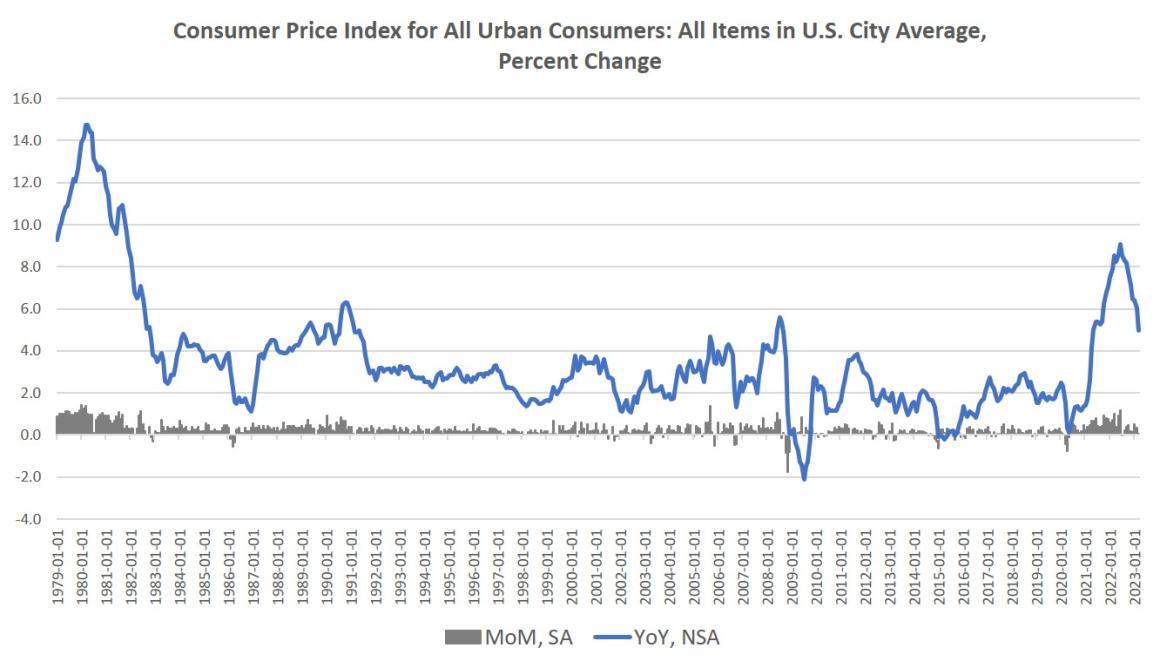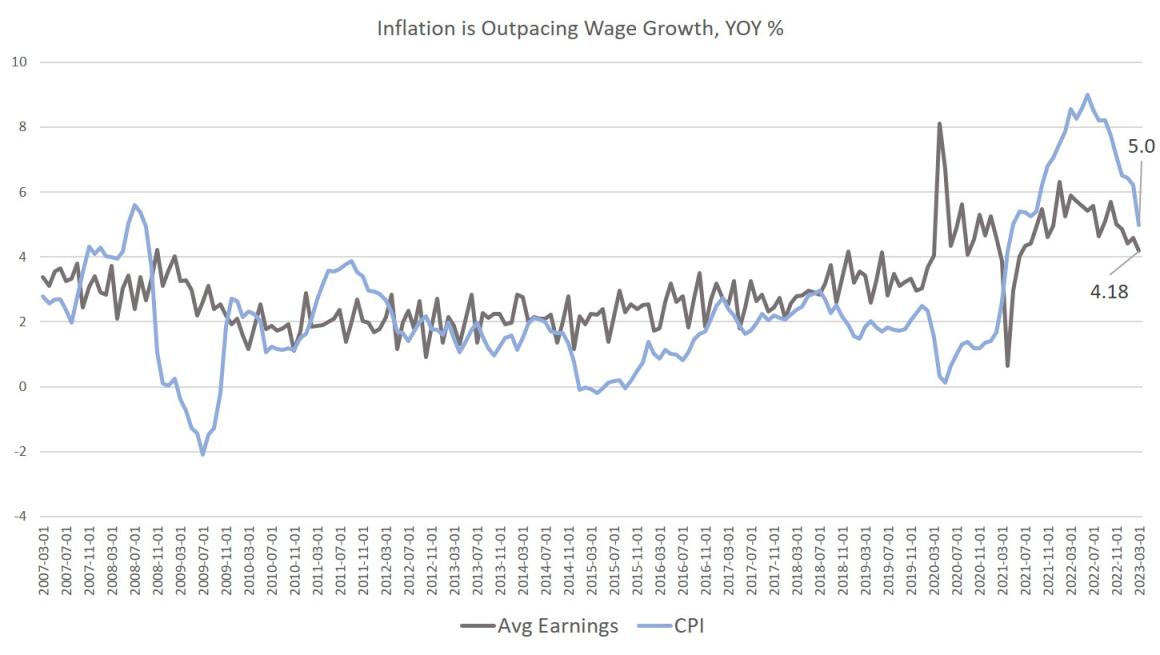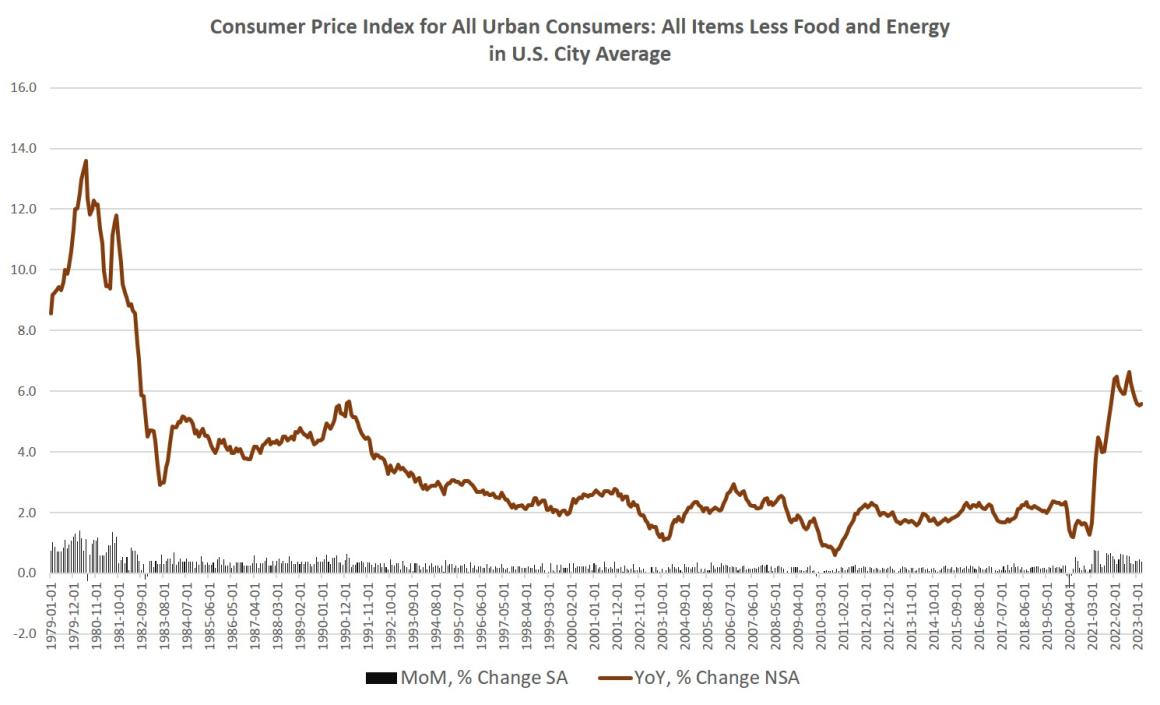The federal government’s Bureau of Labor Statistics (BLS) released new price inflation data last week, and according to the report, price inflation during the month decelerated slightly, coming in at the lowest year-over-year increase in twenty-three months. According to the BLS, Consumer Price Index (CPI) inflation rose 5.0 percent year over year in March before seasonal adjustment. That’s down from February’s year-over-year increase of 6.0 percent, and February is the twenty-fifth month in a row with inflation above the Fed’s arbitrary 2 percent inflation target. Price inflation has now been at or above 5 percent for twenty-three months in a row. Meanwhile, month-over-month inflation rose 0.1 percent (seasonally adjusted) from February to March. That's down from
Topics:
Ryan McMaken considers the following as important: 6b) Mises.org, Featured, newsletter
This could be interesting, too:
Nachrichten Ticker - www.finanzen.ch writes Die Performance der Kryptowährungen in KW 9: Das hat sich bei Bitcoin, Ether & Co. getan
Nachrichten Ticker - www.finanzen.ch writes Wer verbirgt sich hinter der Ethereum-Technologie?
Martin Hartmann writes Eine Analyse nach den Lehren von Milton Friedman
Marc Chandler writes March 2025 Monthly
The federal government’s Bureau of Labor Statistics (BLS) released new price inflation data last week, and according to the report, price inflation during the month decelerated slightly, coming in at the lowest year-over-year increase in twenty-three months. According to the BLS, Consumer Price Index (CPI) inflation rose 5.0 percent year over year in March before seasonal adjustment. That’s down from February’s year-over-year increase of 6.0 percent, and February is the twenty-fifth month in a row with inflation above the Fed’s arbitrary 2 percent inflation target. Price inflation has now been at or above 5 percent for twenty-three months in a row.
Meanwhile, month-over-month inflation rose 0.1 percent (seasonally adjusted) from February to March. That's down from February's month-over-month gain of 0.4 percent.
March’s year-over-year growth rate is down from June’s high of 9.1 percent, which was the highest price inflation rate since 1981. The BLS's CPI inflation rate has now slowed from June's high for nine months in a row.
Growth in CPI inflation has indeed slowed, and this reflects slowdowns in energy, gasoline, used cars and trucks. Food prices continues to rise at an alarming rate, but even there, price increases moderated somewhat with "food at home" slowing from a year-over-year increase of 10.2 percent in February to 8.4 percent in March. Prices in energy overall fell 6.4 percent, year over year, with gasoline dropping 17.4 percent over the same period.
As of March, however, there is still no sign of price growth in shelter slowing down. In March, shelter prices increased by 8.2 percent year over year, which was the highest growth rate since June 1982. Month-over-month growth in shelter costs also remained among the highest we’ve seen since the 1980s.
Meanwhile, March was yet another month of declining real wages, and was the twenty-fourth month in a row during which growth in average hourly earnings failed to keep up with CPI growth. According to new BLS employment data released earlier this month, nominal wages grew with hourly earnings increasing 4.18 percent year over year in March. But with price inflation at 5 percent, real wages fell.
Inflation Is Not “Falling”
Predictably, the Biden administration has attempted to use this slowing in price growth as an excuse to claim inflation is "falling." Last Friday's press release on inflation from the White House reads:
Inflation has now fallen by 45% from its summer peak. Gas prices are down more than $1.40 from the summer, and grocery prices fell in the month of March for the first time since September 2020.
This is a very tortured spin on the statistics. The press release is worded in such a way as to suggest that prices are falling, but this is most certainly not what is going on. Even with energy prices going down, year over year, increases in food and shelter prices are more than enough to ensure that the cost of living continues to go up in real terms. This is especially painful given 24 months of falling real wages.
Interestingly, even the mainstream media seems to have given up on trying to send the message that price inflation is disappearing. NBC News, for example, notes that "the cost of food and shelter remain stubbornly high" while also noting the "wage growth is slowing" and admitting deceleration in prices will happen "only very slowly."
In other words, if you're an ordinary person hoping to get your grocery and rent bills under control, don't expect much relief in the near future.
Moreover, once we look beyond food and energy—the two most volatile components of the CPI—it looks like even more price inflation is baked into the equation. This so-called "core inflation" rate of increase fell to 5.6 percent in March, but that's not down much from the measure's 40-year high of 6.6 percent reached last September. Month-to-month increases also remain elevated with no sign of core-inflation growth turning negative.
This is likely why even the Fed—which always is happy to claim it has everything under control—refuses to declare victory against rising prices. On Wednesday, New York Fed President John Williams declared "“Inflation is still too high" prompting more predictions from Fed watchers that the Federal Open Market Committee (FOMC) will raise the target interest rate again at the committee's next meeting. The Fed knows that price inflation is deeply unpopular with the general public and that its credibility in predicting coming economic trends is lackluster at best. After all, it was not until late 2021 that Fed officials would even admit the price inflation was a problem at all. Up until then, Fed talk about inflation was all about how "transitory" it was. Before that, Fed officials has spent an entire decade talking about how inflation was too low. Even into 2021, Neel Kashkari was stating inflation was perfectly under control and there would be no hikes to the target policy rate until 2023.
The administration has not been any more insightful. Janet Yellen, an economist turned politician who now inhabits the Treasury Secretary position, has consistently been wrong in a similar fashion.
Members of the administration have also been forced to backtrack when trying to convince Congress of their expertise. On Tuesday, for example, Biden advisor Jared Bernstein explained to Congress that "transitory" wasn't really wrong, it was just vague:
“We thought inflation was going to accelerate and gradually cool down over time. Now that has turned out to be in fact the pattern that inflation has taken but ‘transitory’ was much too ambiguous a description of that dynamic."
Berstein insisted that "transitory" should be understood in the context of years, rather than weeks or months.
Clearly, however, this is not what "experts" like Bernstein, Kashkari, and Yellen meant when they said "transitory." Transitory was clearly intended to mean "no big deal" or "don't worry about it." It has always been a political term, not a technical one. Now, after two years of falling wages, many are learning to doubt the experts' narratives. Unfortunately, it's too late to prevent a recession or ongoing malaise. After more than a decade of runaway monetary inflation in the form of quantitative easing, bailouts, and covid stimmies, the stage has been set for widespread bubbles, malinvestments, and economic distortions that can only be unwound with deflation, unemployment, and recession. The disease has always been the easy-money fueled boom. Price inflation is just a symptom.
Tags: Featured,newsletter



